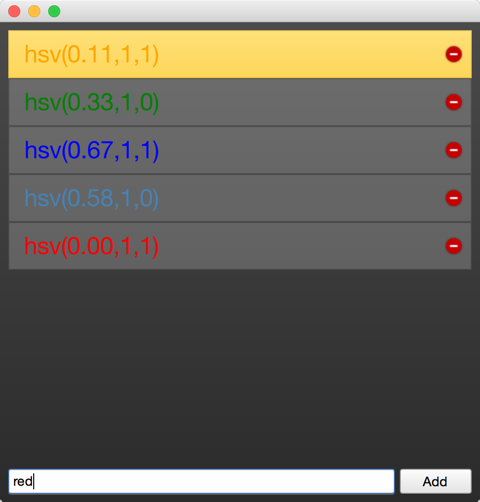动态数据包含了从模型中插入,移除,清除数据等。QAbstractListModel期望当条目被移除或者插入时有一个明确的行为。这个行为使用一个信号来表示,在操作调用前和调用后调用这个行为。例如向一个模型插入一行数据,你首先需要发送beginInsertRows信号,然后操作数据,最后发送endInsertRows信号。
我们将在头文件中加入后续的函数。这些使用Q_INVOKABLE函数定义使得可以在QML中调用它们。另一种方法是将它们定义为公共槽函数。
// inserts a color at the index (0 at begining, count-1 at end)
Q_INVOKABLE void insert(int index, const QString& colorValue);
// uses insert to insert a color at the end
Q_INVOKABLE void append(const QString& colorValue);
// removes a color from the index
Q_INVOKABLE void remove(int index);
// clear the whole model (e.g. reset)
Q_INVOKABLE void clear();
此外,我们定义了count属性来获取模型的大小和一个使用索引值的get方法来获取颜色。这些东西在QML中使用迭代器遍历模型时会用到。
// gives the size of the model
Q_PROPERTY(int count READ count NOTIFY countChanged)
// gets a color at the index
Q_INVOKABLE QColor get(int index);
实现插入数据首先要检查边界和插入值是否有效。在这之后我们开始插入数据。
void DynamicEntryModel::insert(int index, const QString &colorValue)
{
if(index < 0 || index > m_data.count()) {
return;
}
QColor color(colorValue);
if(!color.isValid()) {
return;
}
// view protocol (begin => manipulate => end]
emit beginInsertRows(QModelIndex(), index, index);
m_data.insert(index, color);
emit endInsertRows();
// update our count property
emit countChanged(m_data.count());
}
添加数据非常简单。我们使用模型大小并调用插入函数来实现。
void DynamicEntryModel::append(const QString &colorValue)
{
insert(count(), colorValue);
}
移除数据与插入数据类似,但是需要调用移除操作协议。
void DynamicEntryModel::remove(int index)
{
if(index < 0 || index >= m_data.count()) {
return;
}
emit beginRemoveRows(QModelIndex(), index, index);
m_data.removeAt(index);
emit endRemoveRows();
// do not forget to update our count property
emit countChanged(m_data.count());
}
函数count不太重要,这里不再介绍,只需要知道它会返回数据总数。get函数也十分简单。
QColor DynamicEntryModel::get(int index)
{
if(index < 0 || index >= m_data.count()) {
return QColor();
}
return m_data.at(index);
}
你需要注意你只能返回一个QML可读取的值。如果它不是QML基础类型或者QML所知类型,你需要使用qmlRegisterType或者qmlRegisterUncreatableType注册类型。如果是用户不能在QML中实例化对象的类型应该使用qmlRegisterUncreatableType注册。
现在你可以在QML中使用模型并且可以从模型中插入,添加,移除条目。这里有一个小例子,它允许用户输入一个颜色名称或者颜色16进制值,并将这个颜色加入到模型中在链表视图中显示。代理上的红色圆圈允许用户从模型中移除这个条目。在条目被移除后,模型通知链表视图更新它的内容。
这里是QML代码。你可以在这章的资源里找到完整的源代码。这个例子使用了QtQuick.Controls和QtQuick.Layout模块使得代码更加紧凑。控制模块提供了QtQuick中一组与桌面相关的用户界面元素,布局模块提供了非常有用的布局管理器。
import QtQuick 2.2
import QtQuick.Window 2.0
import QtQuick.Controls 1.2
import QtQuick.Layouts 1.1
// our module
import org.example 1.0
Window {
visible: true
width: 480
height: 480
Background { // a dark background
id: background
}
// our dyanmic model
DynamicEntryModel {
id: dynamic
onCountChanged: {
// we print out count and the last entry when count is changing
print('new count: ' + count);
print('last entry: ' + get(count-1));
}
}
ColumnLayout {
anchors.fill: parent
anchors.margins: 8
ScrollView {
Layout.fillHeight: true
Layout.fillWidth: true
ListView {
id: view
// set our dynamic model to the views model property
model: dynamic
delegate: ListDelegate {
width: ListView.view.width
// construct a string based on the models proeprties
text: 'hsv(' +
Number(model.hue).toFixed(2) + ',' +
Number(model.saturation).toFixed() + ',' +
Number(model.brightness).toFixed() + ')'
// sets the font color of our custom delegates
color: model.name
onClicked: {
// make this delegate the current item
view.currentIndex = index
view.focus = true
}
onRemove: {
// remove the current entry from the model
dynamic.remove(index)
}
}
highlight: ListHighlight { }
// some fun with transitions :-)
add: Transition {
// applied when entry is added
NumberAnimation {
properties: "x"; from: -view.width;
duration: 250; easing.type: Easing.InCirc
}
NumberAnimation { properties: "y"; from: view.height;
duration: 250; easing.type: Easing.InCirc
}
}
remove: Transition {
// applied when entry is removed
NumberAnimation {
properties: "x"; to: view.width;
duration: 250; easing.type: Easing.InBounce
}
}
displaced: Transition {
// applied when entry is moved
// (e.g because another element was removed)
SequentialAnimation {
// wait until remove has finished
PauseAnimation { duration: 250 }
NumberAnimation { properties: "y"; duration: 75
}
}
}
}
}
TextEntry {
id: textEntry
onAppend: {
// called when the user presses return on the text field
// or clicks the add button
dynamic.append(color)
}
onUp: {
// called when the user presses up while the text field is focused
view.decrementCurrentIndex()
}
onDown: {
// same for down
view.incrementCurrentIndex()
}
}
}
}
模型-视图编程是Qt中最难的任务之一。对于正常的应用开发者,它是为数不多的需要实现接口的类。其它类你只需要正常使用就可以额。模型的草图通常在QML这边开始。你需要想象你的用户在QML中需要什么样的模型。通常建议创建协议时首先使用ListModel看看如何在QML中更好的工作。这种方法对于定义QML编程接口同样有效。使数据从C++到QML中可用不仅仅是技术边界,也是从命令式编程到声明式编程的编程方法转变。所以准备好经历一些挫折并从中获取快乐吧。
